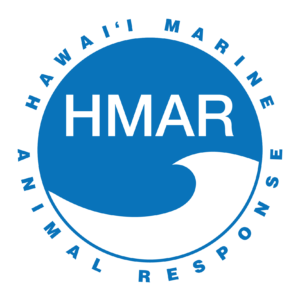MONTHLY HMAR UPDATE: August 2023
August had big sea turtle rescues, marine debris retrievals, and awards! We’re so excited to tell you all about it!
Number of contacts made to HMAR hotlines in August 2023 – 1,209 contacts
This is broken out as 950 calls regarding Hawaiian monk seals, 153 calls regarding sea turtles, 30 calls regarding seabirds, and 76 were calls not regarding marine animals of concern.
Number of field support actions conducted in August 2023 – 326 actions
This was broken out as 25 actions in the east section of Oʻahu, 89 in the lower west area, 4 in the upper west area, 14 in the north section of Oʻahu, and 194 actions in the southeast area.
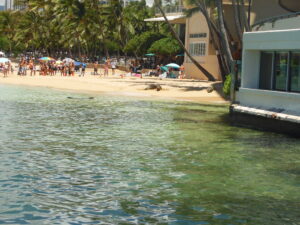 In July, RK96 (“Kaʻiwi”) was hanging out in Waikīkī, and last month, it was RH58 (“Rocky”)! Rocky has been in Waikīkī for the past week or so (see picture left), and joining her are RK24 “Wāwāmalu” and RN14! It has been jam-packed with lots of back and forth between the males and switching beaches.
In July, RK96 (“Kaʻiwi”) was hanging out in Waikīkī, and last month, it was RH58 (“Rocky”)! Rocky has been in Waikīkī for the past week or so (see picture left), and joining her are RK24 “Wāwāmalu” and RN14! It has been jam-packed with lots of back and forth between the males and switching beaches.

In addition, the rest of Oʻahu’s pups now have names! PO3/RS34 is now named “Moana,” and PO4/RS12 is “Hoku,” meaning “deep sea” and “star,” respectively. We are so grateful to Mālama Honua Elementary School in Waimānalo for gifting RS34 and RS12 their names! PO6/RS08 was named “Maluhia,” meaning “peaceful or serenity,” and PO7/RS20 was gifted the name “Lāhina,” meaning “sunray or sunbeam.” Waialua Elementary School gifted RS08 and RS20 their names (see picture right)! Mahalo to our school partners for all their hard work and dedication in gifting these names to our seals! If you want to learn more about the meaning of these names, see our social media post!
Number of rescues, interventions, stranding responses, and escalated field actions in August 2023 – 21
This was broken out as 16 sea turtle rescues, 5 seabird rescues, and 0 Hawaiian monk seal escalated field actions.
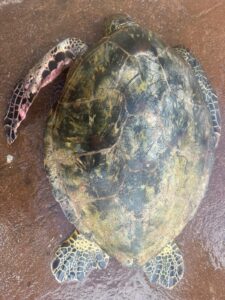 We had two big turtle rescues this month!
We had two big turtle rescues this month! 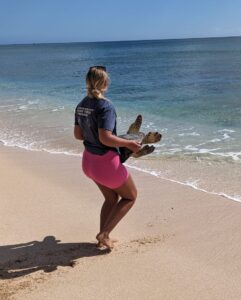
On August 7th, we got a call of a turtle stuck at the intake of the HECO power plant near Electric Beach (see picture left). The workers there pulled the turtle out and noticed it had fishing line wrapped around its left front flipper. Unfortunately, the workers cut the entanglement off of the turtle before calling the hotline. We responded to the turtle, assessed it, and determined it should be brought to NOAA for veterinarian support. Upon further inspection, the turtle’s flipper was necrotic and needed to be amputated. Thankfully, the flipper was amputated without complications and the turtle was released on the west side of Oʻahu last week (see picture right)! This instance is a fantastic reminder of why you should never cut an entanglement off of an animal. If this turtle had been returned to the ocean after the line was removed, that necrotic flipper would have caused many health issues, and the turtle would likely have died. If you find an animal with an entanglement or other injury, you should always call the statewide Marine Animal Hotline at (888) 256-9840 to report it and not attempt to intervene.

Later in the month, we received a call about a turtle swimming at Laniakea with line wrapped around its left front flipper. We were lucky that at the same time, we were getting the call about this turtle, we got a message from one of our rescue volunteers who was reporting a seal a few beaches down the road! Thankfully, our volunteer could go to the beach and locate the turtle for us. She noted that the turtle had line wrapped around the left front flipper and its neck and right front flipper. The turtle was actively swimming and foraging. However, given the extent of the entanglement, we needed to respond. Our responders arrived and found our rescue volunteer, who stayed on site and watched over the turtle for us until we arrived. We were able to walk over to the turtle and collect it with a net. In addition to being wrapped around the front half of the turtle, the line extended into the mouth as well. Using a speculum, we opened the turtleʻs mouth to look inside and noted several tumors inside the mouth, so much so that our responders couldn’t see into the turtleʻs throat. Given these conditions, we felt it best to for veterinarians to make another assessment. We hope to have updates on this turtle for you all in the coming months.
Marine debris – awesome work
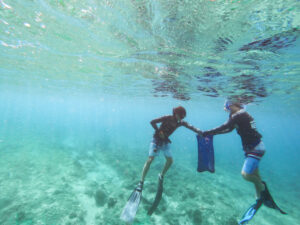
At the beginning of August, two staff members attended the Hawai’i Marine Debris Action Plan (HIMDAP) Workshop. They met with partners and discussed essential action items to prevent and remove marine debris around the islands. It was a very productive day, and we’re excited to continue participating with the HIMDAP community.
This month during 6 dives we collected, 3,691 feet of line and 817 animal hazards! In addition to our dives, we also had six large debris removals from beaches around the island in our role as the Hawaiʻi DLNR Marine Debris Rapid Response contractor on Oʻahu. Altogether, this debris weighed around 700 pounds and primarily consisted of nets!
Number of people reached through face-to-face outreach and education in August 2023 – 2,092
This month, volunteers in our Education & Engagement program had a pretty easy month. We participated in our regular Waikīkī Aquarium outreach events and had the opportunity to educate hundreds of visitors and residents on Hawaiʻi’s marine protected animals, marine debris, and our ocean ecosystem.
Additional news & updates
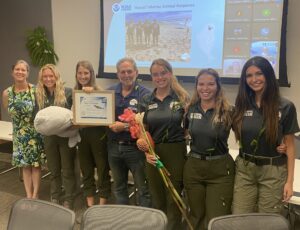
HMAR was awarded the Partner in the Spotlight Award by NOAA Fisheries last month. The Partner in the Spotlight Award is given to one organization annually that works with a species designated as a “Species in the Spotlight” by NOAA. Species in the Spotlight designates that a particular species needs additional attention from the public to ensure its continuation. We are beyond proud of our work with the Hawaiian monk seal population on Oʻahu and Molokai, and we extend a huge mahalo to our partners at NOAA for their help and support over the years.
When we learned we were getting the Partner in the Spotlight award, we knew we also had to recognize our volunteers because we simply could not do what we do without all of them. So we threw them a party! At the end of the month, 20 of our volunteers, our staff, and some of the NOAA team gathered at our facility to celebrate our award and our volunteer accomplishments! We had a great time celebrating with our volunteers!
Mahalo for your support!
______________________________________________________________________________
WHAT DO THESE NUMBERS MEAN?
Number of Calls – What does this mean? These are calls our hotline operators answer about any species in any situation. Whether it is a monk seal on the beach, a sea turtle of concern in the water, or a seabird that needs help. HMAR answers the calls that are made to the NOAA’s marine wildlife number for Oʻahu and Molokai and we take calls from the public, from the police, fire department, Ocean Safety as well as State of Hawaii agencies. Any call that comes into our hotline is reported here. Some calls result in a field response but many are valuable for animal sightings information or other data that can assist in research. Since our start in 2016, we’ve handled over 62,000 hotline contacts.
Number of Field Support Actions – What does this mean? This is when HMAR sends volunteer or staff resources into the field to perform a variety of actions in support of marine protected animals including Hawaiian monk seals, sea turtles, sea birds, dolphins, and whales. Since our start in 2016, we have had volunteers or staff in the field over 27,000 times.
Number of Rescues, Interventions, Stranding Responses and Escalated Field Actions – What does this mean? This number includes any field response that goes above and beyond a typical resting monk seal response. This includes responding to a seal of concern, an entangled, hooked, or injured sea turtle, a seabird in need of medical support, and other situations. Since 2016, we have performed nearly 2,260 of these operations.
Marine Debris Work – Each week our marine debris team removes underwater entanglement hazards (net, line, hooks) from high fishing pressure areas to reduce animal entanglements, hookings, injuries and death of protected marine animals. Since we started our underwater removal activities, our Marine Debris Program (MDP) has removed more than 5,000 animal hazards, cleaned over 275 acres of underwater habitat, and we have collected many MILES of monofilament fishing line. Taking all of this debris out of underwater habitat helps save Hawaiian monk seals, sea turtles, and seabirds.
Number of People Reached through Face to Face Outreach – What does this mean? HMAR’s different program activities put our volunteers and staff in direct contact with Hawaii’s residents and visitors. Educating people about Hawaii’s marine protected species and our ocean ecosystem is one of our highest priorities and has an important impact on reducing threats. This number includes outreach done on the beaches as well as the work our Education and Engagement team does going to classes and community outreach events. Since our start we’ve reached 315,000 people.
